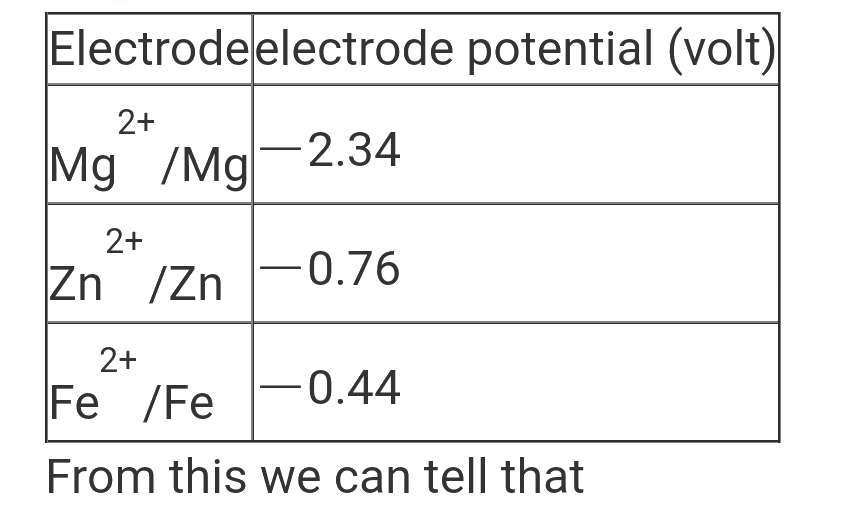The standard reduction potential of the Ag⊕∣Ag electrode at 298K is 0.799V. Given that for AgI,Ksp=8.7×10−17, evaluate the potential of the Ag⊕∣Ag electrode in a saturated solution of AgI.
The correct Answer is:0.325V,−0.149V
Ksp of AgI=[Ag⊕][Ic−]=8.7×10−17
In a saturated solution of AgI
[Ag⊕]=[Ic−]
So, [Ag⊕]=√Ksp=√8.7×10−17=9.33×10−9M
By Nerst equation of Ag⊕+e−→Ag(s)
Ecell=Ec−.cell−0.0591nlog.1Ag⊕
=0.799−0.05911log.19.33×10−9
=0.325V
For standard I⊕|Ag|Ag electrode , [I⊕]=1.0M
Ksp of AgI=[Ag⊕][Ic−]
8.7×10−17=[Ag⊕][1.0]
∴[Ag⊕]=8.7×10−171.0=8.7×10−17
∴ Electrode potential
Ecell=Ec−.cell−0.0591nlog.1[Ag⊕]
EIc−|Ag|Ag=0.799−0.05911log.18.7×10−17
=−0.149V
Topper's Solved these Questions
- ELECTROCHEMISTRYBOOK - CENGAGE CHEMISTRY ENGLISHCHAPTER - ELECTROCHEMISTRYEXERCISE - Archieves True/False
1 Videos
- D AND F BLOCK ELEMENTSBOOK - CENGAGE CHEMISTRY ENGLISHCHAPTER - D AND F BLOCK ELEMENTSEXERCISE - Archives Subjective
29 Videos
- GENERAL PRINCIPLES AND PROCESS OF ISOLATION OF ELEMENTSBOOK - CENGAGE CHEMISTRY ENGLISHCHAPTER - GENERAL PRINCIPLES AND PROCESS OF ISOLATION OF ELEMENTSEXERCISE - Archives (Subjective)
14 Videos
Similar Questions
Knowledge Check
Calculate the reduction potential for the following half cell reaction at 298 K.
Ag+(aq)+e−→Ag(s)
Given that[Ag+]=0.1MandE∘=+0.80VA0.741 VB0.80 VC−0.80VD−0.741V
The standard half-cell reduction potential for Ag+∣Ag is 0.7991 V at 25∘C. Given the experimental value Ksp=1.56×10−10 for AgCl, calculate the standard half-cell reduction potential for the AglAgCI electrode.
View SolutionThe standard reduction potential of Cu2+∣Cu and Ag⊕∣Ag electrodes are 0.337 and 0.799V, respectively. Construct a galvanic cell using these electrodes so that its standard EMF is positive. For what concentration of Ag⊕ will the EMF of the cell , at 25∘C, be zero if the concentration of Cu2+ is 0.01M?
View SolutionThe potential associated. with each electrode is known as electrode potential. If the concentration of each species taking part in the electrode reaction is unity (if any gås appears in the electrode reaction, it is confined to 1 atmospheric pressure) and further the reaction is carried out at 298 K, then the potential of each electrode is said to be the standard electrode potential. By convention, the standard electrode potential of hydrogen electrode is 0:0 volt. The electrode potential value for each electrode process is a measure, of relative tendency of the active species in the process to remain in the oxidized / reduced form. A negative E∘ means that the redox couple is a stronger reducing agent than the H+/H2 couple. A positive E mears that the redox couple is a weaker reducing agent than. the H+/H couple. The metal with greater positive value of standard reduction potentlal forms the oxide of greater thermal stability:
Given the standard reduction potentials.
E∘K+/K=−2.93V,E∘Ag+/Ag=+0.80V,E∘Hg+/Hg=0.79V
E∘Mg+/Mg=−2.37V,E∘Cr3+/Cr=−0.74V
The correct increasing order of reducing power is:
View SolutionThe solubiltiy product of silver iodide is 8.3×10−17 and the standard potential (reduction) of Ag,Ag+ electrode is +0.800 volts at 25∘C. The standard potential of Ag,AgI/I− electrode (reduction) from these data is
View SolutionConsider the following cell reaction at 298 K :
2Ag++Cd→2Ag+Cd2+
The standard reduction potentials (E∘) for Ag+/Ag and Cd2+/Cd are 0.80 V and −0.40V respectively :
(1) Write the cell representation.
(2) What will be the emf of the cell if the concentration of Cd2+ is 0.1 M and that of Ag+ is 0.2 M?
(3) Will the cell work spontaneously for the condition given in (2) above?
View SolutionThe standard electrode potential (reduction) of Ag+∣Ag is 0.800V at 25∘C. Its electrode potential in a solution containing 10−3M ion of Ag+ ions is:-
View SolutionThe standard reduction potential of zinc and silver at 298 K are E0Zn2+Zn=−0.76V, E0Ag+Ag=0.80V Which of the following reactions actually takes place in a cell reaction?
View Solution

